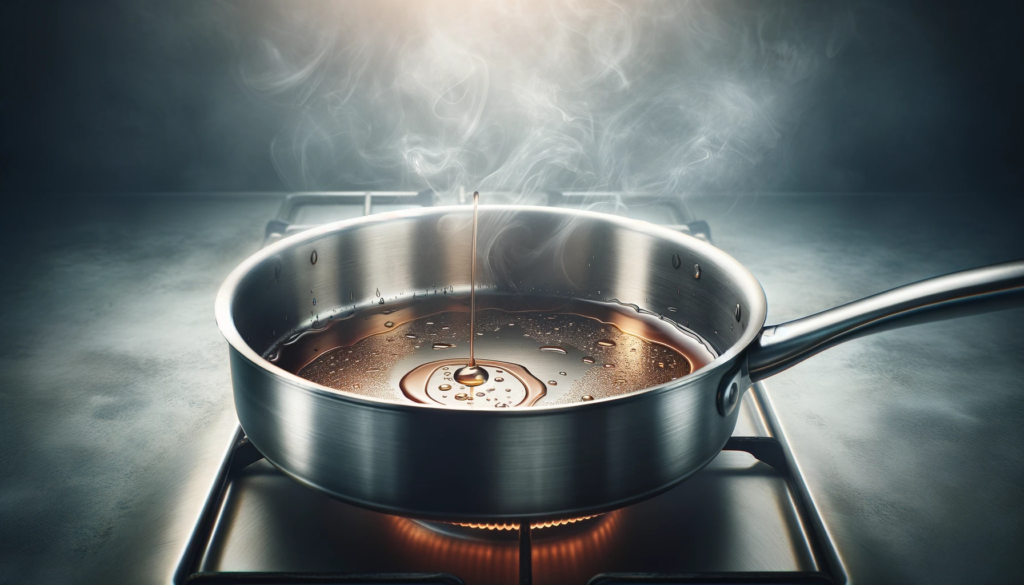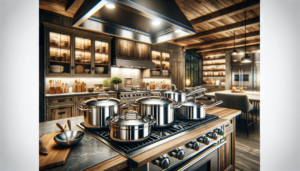Have you ever spent time painstakingly seasoning a brand new stainless steel pan, only to have it emerge from the dishwasher with mysterious greasy splotches marring its mirror finish?
Oil stains on pristine stainless steel pots and pans can be annoying, difficult to remove, and negatively impact cooking performance.
Luckily, by understanding what causes oil stains and learning the best stain removal methods, you can restore stainless cookware to its original sparkling glory.
Let’s dive in to what creates those pesky oil stains on stainless steel and how to banish them for good.
How To Remove Oil Stains From Stainless Steel Cookware

The easiest method for removing light oil stains from stainless steel pans is to apply a small amount of liquid dish soap directly onto the stain.
Let it sit for 2-4 minutes to allow the soap to penetrate and break down grease.
Then use a soft sponge or cloth to gently scrub the stained area before thoroughly rinsing away all soap residue with warm water.
This works best for fresh stains that have not had time to fully set in.
For more stubborn burnt-on oil stains, stronger cleaners like Bar Keepers Friend, baking soda, vinegar or even an ammonia soak may be required.
Below we will explore several methods for removing all varieties of tricky oil stains from stainless steel pots and pans.
What Causes Oil Stains On Stainless Steel Cookware

There are a few common causes of oil stains on stainless steel pans and pots.
Heating oil past its smoke point is a major culprit when it comes to oil stains.
When oils are heated to temperatures exceeding their smoke points, the fats begin to break down and undergo oxidation.
This leaves behind residue that adheres to the surface of stainless steel cookware.
Common cooking oils like olive oil, vegetable oil, and canola oil can leave stubborn stains if overheated on stainless steel.
In addition to heating oil too high, simply cooking fatty or oily foods in stainless steel cookware can lead to difficult oil stains over time.
Foods like bacon, ground beef, breaded foods, and fried dishes deposit hot grease on the surface of pots and pans if not promptly cleaned.
Allowing these food particles and oily residues to sit on stainless steel makes removing them much more challenging.
Finally, improperly cleaning stainless steel pans by failing to remove all traces of oil enables future stains.
Leaving dried-on cooking oils and food greases on cookware creates a magnet for future sticking and burning.
Proper cleaning after cooking is key to preventing the accumulation of oil that carbonizes into stains.
Removing Light Oil Stains

Dish Soap and Warm Water
For light or fresh oil stains that have not had time to set in and bake onto the metal, dish soap and warm water can often do the trick.
Apply a small amount of liquid dish soap directly onto the stained area of the stainless steel pot or pan.
Allow the soap to sit for two to four minutes to penetrate the grease.
Then use a soft sponge or damp cloth to gently scrub at the stain.
The surfactants in dish soap will lift grease and emulsify oils.
Avoid abrasive scrubbing as this can scratch the stainless steel surface.
After scrubbing for several minutes, thoroughly rinse away all soap residue under warm running water.
Check if the stained area looks clean.
Repeat the process if any oil stain remains.
The key is to use this method shortly after cooking, before residue has a chance to fully carbonize.
For older, more stubborn oil stains, stronger methods will be required.
Baking Soda
Baking soda is a versatile mild abrasive cleaner good for lifting away minor oil stains on stainless steel.
To use it, make a wet paste by sprinkling baking soda directly onto the stained area of the cookware.
Add just enough water to form a spreadable paste – usually one to two tablespoons.
Use a soft cloth or sponge to gently rub the paste over the stain.
Allow the paste to set for ten to fifteen minutes before resuming scrubbing.
The tiny granules in the baking soda will help gently scour the steel surface without scratching.
Baking soda also acts as a degreaser and neutralizer to dissolve greasy residues.
After letting it sit and scrubbing, thoroughly rinse away all baking soda paste under warm running water.
Dry completely with a soft towel.
Repeat if any faint stain remains.
Baking soda offers a safer, non-toxic way to erase early-stage oil stains.
White Vinegar
As a mild acid, white vinegar can work to dissolve and lift many oil and grease stains.
Pour undiluted white vinegar directly over the stained area of the stainless steel cookware until fully submerged.
Let the vinegar sit for fifteen to twenty minutes, allowing it time to break down fatty acids in the oil residue.
Then use a damp sponge or cloth to gently scrub at the stain to lift debris from pores in the steel.
Rinse very thoroughly with warm water and check if the stain has lifted.
Vinegar offers the advantage of being able to lift stains while simultaneously disinfecting and deodorizing the steel surface.
However, those with sensitive skin may wish to wear waterproof gloves, as prolonged exposure to acidic vinegar can cause skin irritation for some.
Removing Stubborn Or Burnt-On Oil Stains

Barkeepers Friend Cleanser
For truly stubborn, burnt-on oil stains that other remedies cannot tackle, a specialist stainless steel cleanser is in order.
Bar Keepers Friend is a commercial cleaner long trusted for removing the most stubborn stains from stainless steel surfaces.
It contains oxalic acid and silicates that can break down carbonized oils when combined with physical scrubbing.
To use Barkeepers Friend, first wet the stained area of the stainless steel pan or pot.
Sprinkle the cleanser powder directly over the oil stain and allow it to sit for approximately five minutes.
Add a little water if needed to form a thick paste.
Next, wearing rubber gloves, scrub at the stain using a plastic bristle brush, sponge or soft cloth.
Take care, as vigorous scrubbing is often needed to lift difficult stains.
Thoroughly rinse cookware under hot running water once finished scrubbing.
Check carefully if any stain remnants linger, repeating the process if needed.
Barkeepers Friend allows you to aggressively target oil stains without damaging steel cookware surfaces when used as directed.
Ammonia
For the ultimate overnight treatment of excessively stubborn burnt-on oil stains, an ammonia soak can do the job.
To perform an ammonia treatment, place the stained stainless steel cookware inside a sealable plastic bag.
Avoid breathing in fumes directly from the bottle and wear gloves when handling ammonia.
Pour one-quarter cup of clear household ammonia into the bag and carefully seal it closed.
Make sure the stained portion of cookware is fully submerged in liquid inside the sealed bag.
Let the ammonia-filled bag sit undisturbed overnight, giving the ammonia time to react with the stain.
The next day, carefully remove cookware from bag and thoroughly scrub oil stain under warm running water with a plastic brush or abrasive sponge.
An ammonia soak allows for prolonged chemical breakdown of even the most persistent oil burns on stainless steel pans and pots.
Maintenance Tips To Prevent Oil Stains

Hand Wash Pans
Though stainless steel cookware stands up well to dishwasher cycles, hand washing pans after use is still best practice to prevent oil stains over time.
The high heat and harsh detergents in dishwashers can bake on oil residues if not promptly removed.
Washing by hand allows you to immediately target any cooking oils, greases or food debris that could develop into stains if neglected.
Get in the habit of hand washing stainless pans shortly after cooking for easiest upkeep.
Dry Thoroughly After Washing
Just as important as washing, fully drying stainless steel cookware prevents moisture from interacting with unseen fats and oils.
Trapped moisture can allow residue to oxidize and stick to the steel surface.
After hand washing pans, carefully dry with a soft lint-free cloth.
Ensure hard-to-reach spots like handles and rivets are completely moisture-free.
Allow pans to fully air dry before putting away to discourage water spots or adhesion of residues.
Getting pans bone dry after washing limits staining issues down the road.
Avoid Excessive Heat When Cooking With Oil
Lastly, employing proper cooking habits goes a long way towards preventing oil stains on stainless pots and pans.
Avoid heating oil past its smoke point temperature whenever possible.
Monitor heat carefully when frying or sautéing foods in oil, adjusting temperature as needed.
Take care not to leave pans unattended.
Remove cookware from heat immediately if oils begin smoking heavily.
Preventing oil smoke will help maintain clean stainless steel surfaces long-term.
Conclusion
Properly caring for stainless steel cookware by handwashing after use and thoroughly drying can help prevent oil stains from forming in the first place.
But even if stains do occur from overheating oil or failing to promptly clean pans, this guide offers multiple safe and effective methods for dissolving and scrubbing away grease and burnt-on food residues.
Getting into a habit of prompt cleanup, using the right stain removal techniques, and taking steps to prevent overheating oil will keep stainless steel shiny and spotless for years of cooking enjoyment.



